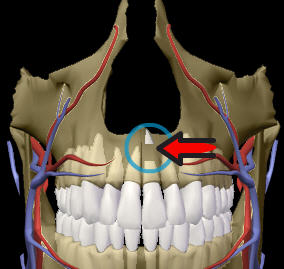Actually a toothache is never really the fault of the tooth, but rather the fault of the dentist or the patient!
Generally we speak of infections or cysts, and specifically infections in the bone.
Cysts in the mouth, or to be more precise, the jaw, are usually caused by infections in the bone – more on this tomorrow.
What causes infections in bones?
 It starts when the dental nerve is damaged, e.g. by cavities or bad brushing habits (the patient’s fault). Or the dentist may inadvertently damage the nerve while drilling, either by drilling too deep or not providing sufficient cooling for the tooth, which leads to overheating – basically the nerve gets cooked).
It starts when the dental nerve is damaged, e.g. by cavities or bad brushing habits (the patient’s fault). Or the dentist may inadvertently damage the nerve while drilling, either by drilling too deep or not providing sufficient cooling for the tooth, which leads to overheating – basically the nerve gets cooked).
Some other causes could be the chemicals used by the dentist, or white fillings – called composites – all this being the patient’s fault: more on this topic here.
–
–
Once the nerve is damaged, you get a toothache lasting for several days!
 Some of you may go to a dentist, while others do not, since the pain goes away after a while. What you may not know is that this is simply because the nerve is dead. But now the nerve begins to rot, just like meat which has been lying out in the sun. This rotting leads to an infection in the bone – and then you again have a toothache. This process can last days, weeks, months or even years. Once the infection is acute, you feel pain when you put pressure on your teeth, like when you chew. Chronic infections don’t tend to hurt, though.
Some of you may go to a dentist, while others do not, since the pain goes away after a while. What you may not know is that this is simply because the nerve is dead. But now the nerve begins to rot, just like meat which has been lying out in the sun. This rotting leads to an infection in the bone – and then you again have a toothache. This process can last days, weeks, months or even years. Once the infection is acute, you feel pain when you put pressure on your teeth, like when you chew. Chronic infections don’t tend to hurt, though.
–
–
If your nerve damage has become acute, and you go to the dentist , then you still face the luck of the draw!
Root treatment – the lucky ones!
 If the root is treated properly, using sterile root canal instruments, and using a coffer dam, then the damage caused by the nerve can be repaired, and you will soon be smiling again: to the left you can see a tooth after proper treatment, and to the right one which wasn’t treated properly.
If the root is treated properly, using sterile root canal instruments, and using a coffer dam, then the damage caused by the nerve can be repaired, and you will soon be smiling again: to the left you can see a tooth after proper treatment, and to the right one which wasn’t treated properly.
The losers
Poorly performed treatment can lead to another infection days, weeks or even years later. And now we’re back to square one!








